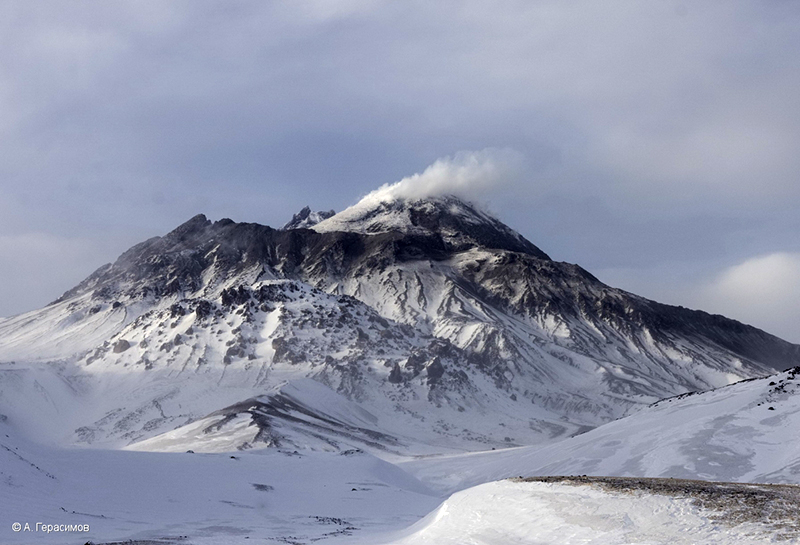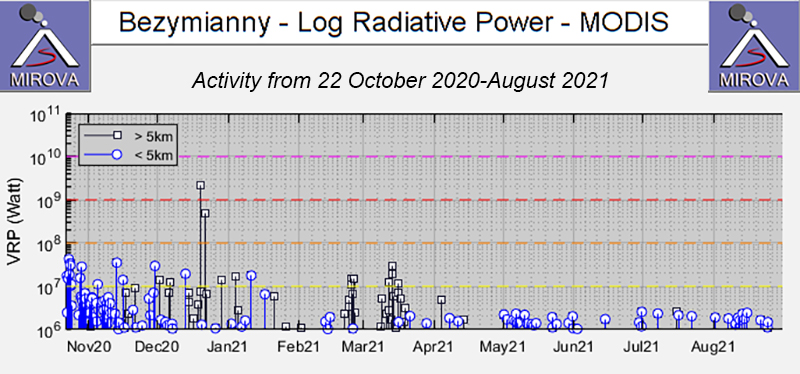Report on Bezymianny (Russia) — September 2021
Bulletin of the Global Volcanism Network, vol. 46, no. 9 (September 2021)
Managing Editor: Edward Venzke.
Edited by Kadie L. Bennis.
Bezymianny (Russia) Frequent gas-and-steam emissions and a weak thermal anomaly during March-August 2021
Please cite this report as:
Global Volcanism Program, 2021. Report on Bezymianny (Russia) (Bennis, K.L., and Venzke, E., eds.). Bulletin of the Global Volcanism Network, 46:9. Smithsonian Institution. https://doi.org/10.5479/si.GVP.BGVN202109-300250
Bezymianny
Russia
55.972°N, 160.595°E; summit elev. 2882 m
All times are local (unless otherwise noted)
Bezymianny, part of the Klyuchevskoy volcano group on the Kamchatka Peninsula, has had frequent eruptions dating back to 1955. The current eruptive period began in May 2010 and has recently consisted of lava dome growth, strong fumarolic activity, and thermal anomalies (BGVN 46:03). This report covers similar low activity of white gas-and-steam emissions and a persistent, weak thermal anomaly at the summit crater during March through August 2021 using weekly and daily reports from the Kamchatka Volcano Eruptions Response Team (KVERT) and satellite data.
Activity at Bezymianny was relatively low during the reporting period, mostly consisting of frequent moderate gas-and-steam emissions (figure 44) and a weak thermal anomaly over the lava dome in the summit crater. The MIROVA (Middle InfraRed Observation of Volcanic Activity) volcano hotspot detection system based on the analysis of MODIS data showed intermittent low-power thermal anomalies during late March through August (figure 45). These low-power anomalies were also detected in the summit crater, occasionally accompanied by white gas-and-steam emissions on clear weather days, based on Sentinel-2 infrared satellite images (figure 46).
 |
Figure 44. Photo of Bezymianny showing strong fumarolic activity on 30 March 2021. Photo by A. Gerasimov, IVS FEB RAS. Courtesy of IVS FEB RAS, KVERT. |
 |
Figure 45. Intermittent low-power thermal anomalies at Bezymianny were detected by the MIROVA system (Log Radiative Power) during late March through August 2021. Courtesy of MIROVA. |
Geological Summary. The modern Bezymianny, much smaller than its massive neighbors Kamen and Kliuchevskoi on the Kamchatka Peninsula, was formed about 4,700 years ago over a late-Pleistocene lava-dome complex and an edifice built about 11,000-7,000 years ago. Three periods of intensified activity have occurred during the past 3,000 years. The latest period, which was preceded by a 1,000-year quiescence, began with the dramatic 1955-56 eruption. This eruption, similar to that of St. Helens in 1980, produced a large open crater that was formed by collapse of the summit and an associated lateral blast. Subsequent episodic but ongoing lava-dome growth, accompanied by intermittent explosive activity and pyroclastic flows, has largely filled the 1956 crater.
Information Contacts: Kamchatka Volcanic Eruptions Response Team (KVERT), Far Eastern Branch, Russian Academy of Sciences, 9 Piip Blvd., Petropavlovsk-Kamchatsky, 683006, Russia (URL: http://www.kscnet.ru/ivs/kvert/); MIROVA (Middle InfraRed Observation of Volcanic Activity), a collaborative project between the Universities of Turin and Florence (Italy) supported by the Centre for Volcanic Risk of the Italian Civil Protection Department (URL: http://www.mirovaweb.it/); Sentinel Hub Playground (URL: https://www.sentinel-hub.com/explore/sentinel-playground).


